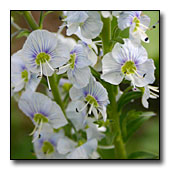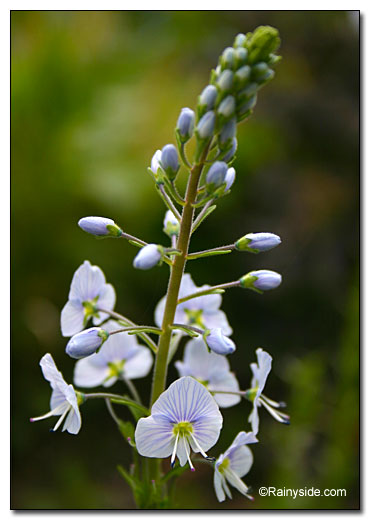Veronica gentianoides
SPEEDWELL
Family: Scrophulariaceae
Pronounced: ve-RO-ni-ka gen-tewe-a-NOI-deez

Quick Jumps
Growing Guide
Rainy Side Notes
GROWING GUIDE

Geographical Origin:
Ukraine, North and Central Turkey, Caucasus.
Plant Group:
Perennial.
Hardiness:
Sunset zones: 1-9, 14-21.
USDA zones: 4-7.
Heat zones: 7-1.
Mature size:
Height: 18 inches (45 cm).
Width: 18 inches (45 cm).
Flowering period:
Late spring through early summer.
Flowering attributes:
Pale blue with darker blue veining, cup-shaped flowers on 12 inch long racemes.
Leaf attributes:
Oblong-lanceolate, slightly toothed, dark green leaves. Basal leaves
form a rosette.
Growth habit:
Mat forming.
Light:
Full sun to partial shade.
Soil:
Humus rich, moist, well-drained soil is best.
Feeding:
Side dress with compost or manure, and a complete organic fertilizer in spring.
Propagation Methods:
Sow seed at 68-86°F (20-30°C), barely cover as they need light to germinate. Sources say germination is in 21-60 days. Mine germinated within 15 days on a heat mat. | Divide in spring or fall.
Pruning Methods:
Deadhead to promote a long bloom season. Cut back plants to basal foliage around mid autumn.
Pests, Diseases or Other Problems:
Root rot may be a problem in our notorious Pacific Northwest wet winters, if soil is not well-drained. Powdery mildew is reported to be a possible problem. It has not been a problem on my own plants.
Rainy Side Notes
Veronica gentianoides is a charming mat-forming perennial with pale blue flowers and darker blue veining. In its nativity, this speedwell grows in mountain meadows and open woods. The genus is reportedly named after St. Veronica. Its epithet, gentianoides, means gentian-like, since the leaves resemble gentian leaves.
Gentian speedwell adds a delicate aspect to the garden and is suitable for the front of the border or planted in drifts. Since speedwell is easy to start from seed, sow enough for a large drift. The small perennials bloom in their second season, and by season three, their presence is well established in the garden. The little plants aren’t drought tolerant, so when our annual dry season rolls around, water them regularly.
Photographed in author's garden.
A Pacific Northwest Plant of the Week (2012)

Gardening for the Homebrewer: Grow and Process Plants for Making Beer, Wine, Gruit, Cider, Perry, and More
By co-authors Debbie Teashon (Rainy Side Gardeners) and Wendy Tweton
Copyright Notice | Home | Search | Perennials

